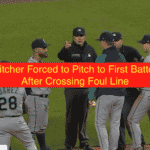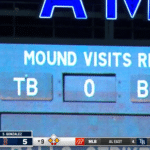TRIPS TO THE MOUND
Rule 5.10(L):
Note regarding translators: Standards and On-Field Operations Regulation 2-2 (“Occupying the Bench”) provides that a full-time interpreter is permitted to enter the playing field during a game to translate for a coach or manager on an official visit to the pitcher as well as for the evaluation of an injury of a player. An interpreter may enter the field unaccompanied by a manager or coach during a pitching change at the start of an inning. In such instance, the interpreter must exit the field prior to the pitcher beginning warm-up throws. Other than this scenario, interpreters are not permitted onto the playing field at any time without the presence of a coach, manager, or trainer with the interpreter, including when a catcher and/or infielder(s) visit the mound.
A second trip to the mound to the same pitcher in the same inning by a manager or coach will cause that pitcher’s removal from the game. The manager or coach is prohibited from making a second visit to the mound while the same hitter is at bat, but if a pinch hitter is substituted for this batter, the manager or coach may then make a second visit to the mound, but must then remove the pitcher.
For the purpose of this rule, a batter’s time at bat begins the moment the preceding batter is put out or becomes a base runner.
There will be a 30 second time limit on all manager or coach visits to the mound. When there are 10 seconds remaining on the timer, the home plate umpire should begin to approach the mound. When the clock reaches 0, the home plate umpire shall break up the mound visit and direct the manager or coach to return to the dugout. The home plate umpire shall have discretion to grant a brief window of additional time to a manager or coach whose trip to the mound was slowed by a bona fide physical ailment or other special circumstance (e.g., chronic knee pain, respiratory condition, player requiring a translator). In addition, the timer shall not operate when a doctor or trainer accompanies the Manager or Coach to evaluate a bona fide medical issue.
• A trip to the mound begins when the manager or coach crosses the foul line.
• The trip ends when the manager or coach leaves the 18-foot circle surrounding the pitcher’s rubber.
A consequence of the rule regarding trips to the mound is that once a manager or coach has completed a trip to the mound, the pitcher then pitching must continue pitching to the batter then at bat (or retire the side) unless a pinch hitter is substituted or unless one of the following situations applies:
(a) If a game becomes suspended during a manager’s or coach’s trip to the mound (or after the trip but while the same batter is still at bat), a new pitcher may be substituted when the game is later resumed.
(b) If a rain delay occurs during a manager’s or coach’s trip to the mound (or after the trip but while the same batter is still at bat), a new pitcher may be substituted when the game is resumed following the rain delay.
If the manager or coach goes to the catcher or an infielder and that player then goes to the mound—or the pitcher goes to that player at the player’s position—before there is an intervening play (a pitch or other play), that will be the same as the manager or coach going to the mound.
If a catcher or other player goes to the dugout or manager and then immediately to the mound, that will be deemed a trip.
If a pitcher is removed and the manager or coach remains to talk to the new pitcher, this is not charged as a visit to the new pitcher.
If a coach goes to the mound and removes a pitcher and then the manager goes to the mound to talk with the new pitcher, that will constitute one trip to that new pitcher that inning.
If a manager changes pitchers and leaves the mound, he (or a coach) may come out again to visit the pitcher while the same batter is at bat, but this will constitute one trip to that new pitcher that inning.
If the manager and pitcher are both ejected at the same time, a coach or acting manager may visit the mound to meet with the new pitcher prior to play resuming without a trip being charged—provided that the manager who has been ejected has not already conferred with and left the new pitcher.
For example, if the pitcher and manager are both ejected and a new pitcher takes the mound alone, a coach may come out of the dugout and go to the mound while the new pitcher is warming up without a trip being charged. On the other hand, if the ejected manager remains on the mound until the new pitcher arrives, a subsequent visit to the new pitcher by a member of the coaching staff prior to resumption of play constitutes a trip to the new pitcher.
If a manager or coach’s conference with the pitcher takes place on the grass (i.e., off the dirt of the mound), this constitutes a trip. If a manager or coach confers with the pitcher on the grass (or the meeting “moves” from the dirt to the grass), the trip ends when the manager or coach “breaks” from the meeting. He must then keep going and not return to the pitcher.
Any attempt—in the umpire’s judgment—to circumvent this rule shall be deemed a trip.
In a case where a manager or coach has made his first trip to the mound and then attempts to return a second time to the mound in the same inning with the same pitcher in the game and the same batter at bat, he shall be warned by the umpire that this is not permitted. If the manager or coach ignores such warning, the manager or coach shall be removed from the game and the pitcher required to pitch to the batter then at bat until such batter is retired or gets on base (or the side is retired). After the batter is retired, or becomes a base runner (or the side is retired), then this pitcher must be removed from the game. The manager should be notified that the pitcher will be removed from the game after pitching to one hitter, in order that the manager can have a substitute pitcher warmed up. In such circumstance, the substitute pitcher will be allowed as much time to throw preparatory pitches as in the umpire’s judgment circumstances justify.
NOTE: If through umpire oversight or inability to warn the manager or coach, the manager or coach is inadvertently allowed to go to the mound a second time while the same batter is at bat (without the manager or coach being warned that he cannot do so), the pitcher then pitching will be required to pitch to the batter then at bat until the batter is retired or gets on base (or the side is retired). After the batter is retired or becomes a base runner (or the side is retired), this pitcher must then be removed from the game. However, because the umpire did not warn the manager or coach that a second trip to the mound was not permitted while the same batter was at bat, the manager or coach is NOT ejected from the game in this situation. It is only when the manager or coach ignores the umpire’s warning of no second trip that the ejection applies.
The manager may request permission from the umpire to visit the mound in case of injury or illness of the pitcher, and with permission granted it will not be counted as a visit to the mound. The plate umpire shall accompany the manager or coach in such situations and remain in the vicinity of the conference to ensure this regulation is not abused. The opposing manager is to be informed at the conclusion of the conference that this was not a trip. The umpire has the sole authority to count or “wave off ” the trip. A trainer does not have to accompany the manager to the mound for the umpire to “wave off” the trip.
In the case of a player-manager, in the judgment of the umpire any visit to the mound will constitute a trip. The umpire shall notify the player-manager and the opposing manager each time a trip is charged.
In the case of a player-coach, while playing the coach will be treated as a player until he is considered to have abused the privilege. If, in the judgment of the umpire, the privilege is abused, the player-coach and his manager will be advised that any future visits to the mound will be charged as trips.




